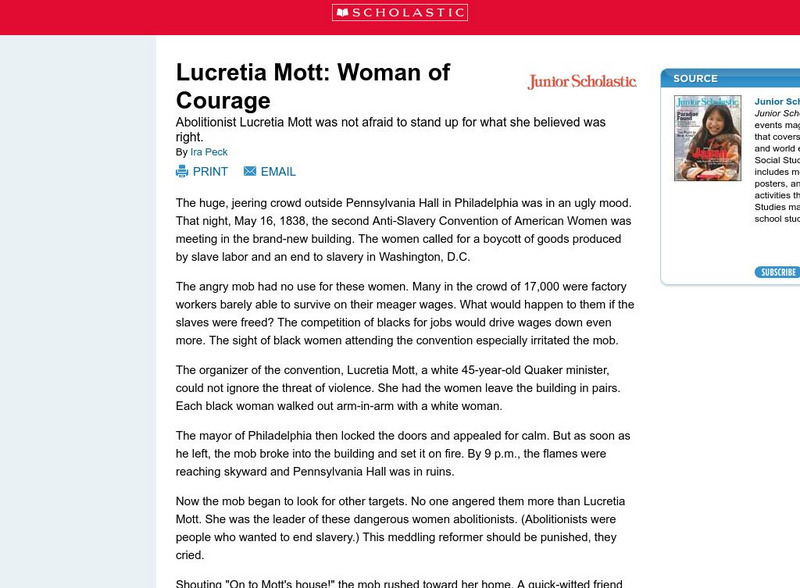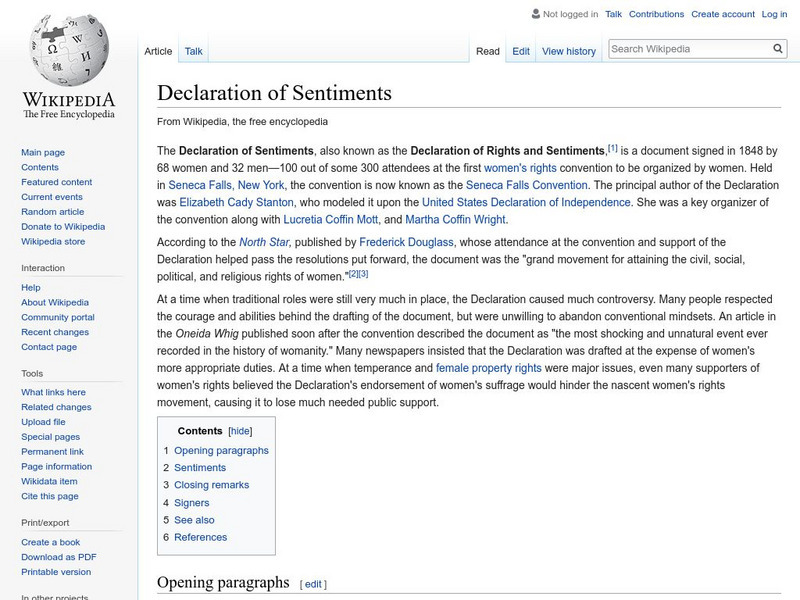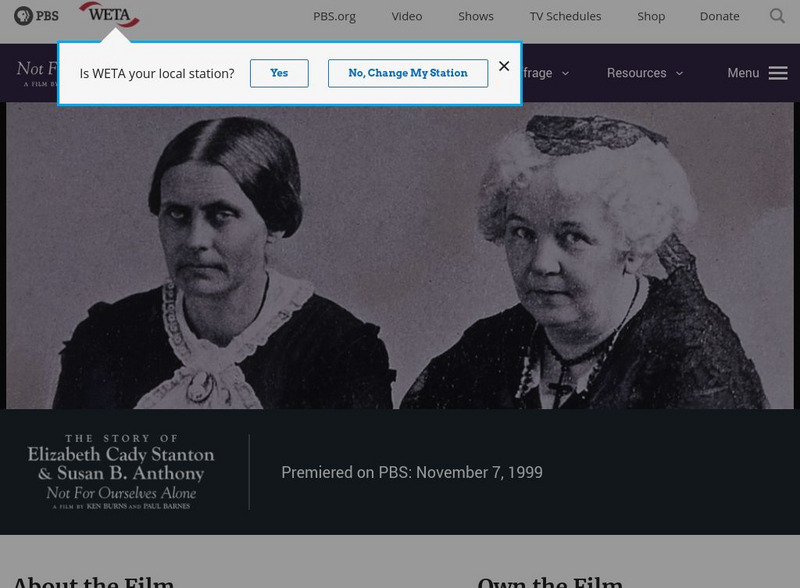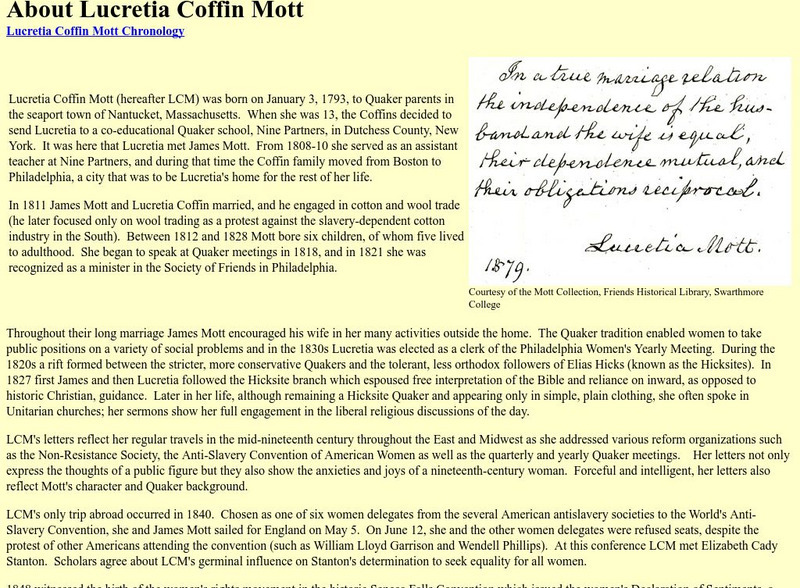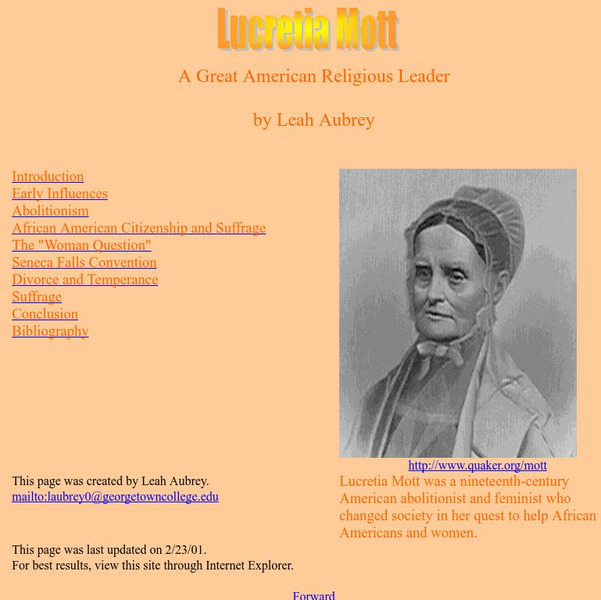Hi, what do you want to do?
Curated OER
Defending the Rights of Women
The women's rights movement is the fascinating story of the individuals who fought for a change of the status quo.
Curated OER
Seneca Falls Convention: Declaration of Sentiments
The Seneca Falls Convention was an amazing outlet for the female voice during the time of women's suffrage. Learners will read a short, but powerful excerpt from the Declaration of Sentiment, as spoken at the convention. They'll answer...
Curated OER
Women's Suffrage: Their Rights and Nothing Less
Students explore women's rights. In this women's history lesson, students examine primary and secondary sources regarding the women's suffrage movement in the United States. Students compare and contrast the states' methods for achieving...
Scholastic
Scholastic: Women's Suffrage
Find out about women's suffrage not only in the United States, but around the world. An interactive map displays the dates women gained their right to vote.
US National Archives
Nara: Teaching With Documents: Petition of Amelia Bloomer Regarding Suffrage
Amelia Bloomer was a prominent advocate of women's rights in the 19th century. She invented bloomers to replace the skirt hoop, in an effort to free women from much of their cumbersome apparel. She later used her newspaper, The Lily, to...
Curated OER
National Park Service: Elizabeth Cady Stanton
This NPS website contains a biography on Elizabeth Cady Stanton, the driving force behind the 1848 Convention and a leader in the women's rights movement.
OpenStax
Open Stax: Women's Rights
From a chapter on " Antebellum Idealism and Reform Impulses," this section explains the connections between abolition, reform, and antebellum feminism and also describes the ways antebellum women's movements were both traditional and...
C3 Teachers
C3 Teachers: Inquiries: Women's Rights
A comprehensive learning module on women's rights that includes three supporting questions accompanied by formative tasks and primary source materials, followed by a summative performance task. Topics covered include the women's suffrage...
National Women’s History Museum
National Women's History Museum: Report of the Women's Rights Convention
Complete proceedings of the 1848 Seneca Falls Convention advocating women's rights.
Other
Library Bulletin: Upstate New York and the Women's Rights Movement
A comprehensive list of books and documents available in the University of Rochester Rare Books and Special Collections exhibit of 1995. Brief summaries of the books, documents and their authors are available at this site.
Library of Congress
Loc: American Memory: Draft Elizabeth Cady Stanton's the Woman's Bible
This site features a draft of Elizabeth Cady Stanton's The Woman's Bible and summarizing text from Library of Congress.
Library of Congress
Loc: Elizabeth Cady Stanton Papers
The papers of suffragist, reformer, and feminist theorist Elizabeth Cady Stanton cover the years 1814 to 1946, with most of the material concentrated between 1840 and 1902. Consisting of approximately 1,000 items, the collection contains...
National Women’s History Museum
National Women's History Museum: Seneca Falls Convention
Students will examine primary sources about the Seneca Falls Convention in 1848 to understand why a women's rights movement was necessary to gain greater rights for women.
National Women’s History Museum
National Women's History Museum: The Road to Suffrage
In this lesson plan, students will use the Suffrage Timeline to explore the women, ideas, and action that led to the ratification of the 19th Amendment in 1920 and discuss the Woman Suffrage Movement as a model for peaceful activism.
Library of Congress
Loc: Seneca Falls and Building a Movement, 1776 1890
The story of the Seneca Falls convention is told through words, pictures, and primary sources.
Internet History Sourcebooks Project
Fordham University: Modern History Sourcebook: The Declaration of Sentiments
This resource gives an introduction to "The Declaration of Sentiments" from the Seneca Falls Conference in 1848, which demanded rights for women, as well as a full text accompanying it.
Scholastic
Scholastic: Lucretia Mott: Woman of Courage
Read about the issues that motivated Lucretia Mott to become an abolitionist and fighter for women's rights.
Wikimedia
Wikipedia: Declaration of Sentiments
This Wikipedia page provides the text of the Seneca Falls Declaration of Sentiments, a document signed in 1848 by sixty-eight women and thirty-two men, delegates to the first women's rights convention in Seneca Falls, New York.
PBS
Pbs: Resources for the Study of Nineteenth Century Women's Rights Reformers
The developers "Not For Ourselves Alone," a PBS documentary about the lives and work of Susan B. Anthony and Elizabeth Cady Stanton, have compiled a collection of resources useful to any study of the history of women's suffrage in...
Other
Lucretia Coffin Mott Papers Project: About Lucretia Coffin Mott
This site contains biographical information about Lucretia Mott and also contains a chronology of her life.
Other
Georgetown College: Lucretia Mott: A Great American Religious Leader
This is a very in-depth, student-written biography on the life of Lucretia Mott. Read about her early influences, the Seneca Falls Convention, and her involvement with the suffrage movement.
Other
Student Historical Journal 1984 1985: Women's Rights Before the Civil War [Pdf]
Read an overview of the pre-Civil War women's rights movement in a student essay in an historical journal from Loyola University. Find out about specific activists prominent during this time period and learn about their attempts to...
US Department of State
America.gov: Seneca Falls Convention Began Women's Rights Movement
Learn about the convention that not only paved the way for women's rights but also lead to women's suffrage. This article describes the political climate that motivated Elizabeth Cady Stanton, Lucretia Mott, and other proponents of...
Smithsonian Institution
National Portrait Gallery: American Women: Portrait of Lucretia Mott
An interesting portrait of Lucretia Mott and a brief account of her activities as a social reformer.


















